Intro: Why Most Lead Magnet Funnels Fail (And What to Do Instead)
Most people get this part dead wrong.
They obsess over email tools. They spend hours designing the perfect landing page. They buy fancy automation software. And then they wonder why no one’s signing up.
The truth? Lead magnet funnels don’t fail because of tech. They fail because of boring offers.
If your lead magnet isn’t solving a real, painful, specific problem… nothing else matters. No one cares about “free value” unless it hits a nerve, makes life easier, or unlocks something they want.
Here’s the good news: You don’t need a full-blown eBook. You don’t need 10 emails. And you don’t need to be a marketing guru.
You just need one irresistible offer… a simple way to deliver it… and a short, sharp follow-up that builds trust.
In this post, I’ll walk you through how to build a lead magnet funnel from scratch.
No fluff. No tech overwhelm. Just clear steps, real examples, and tools you can use today.
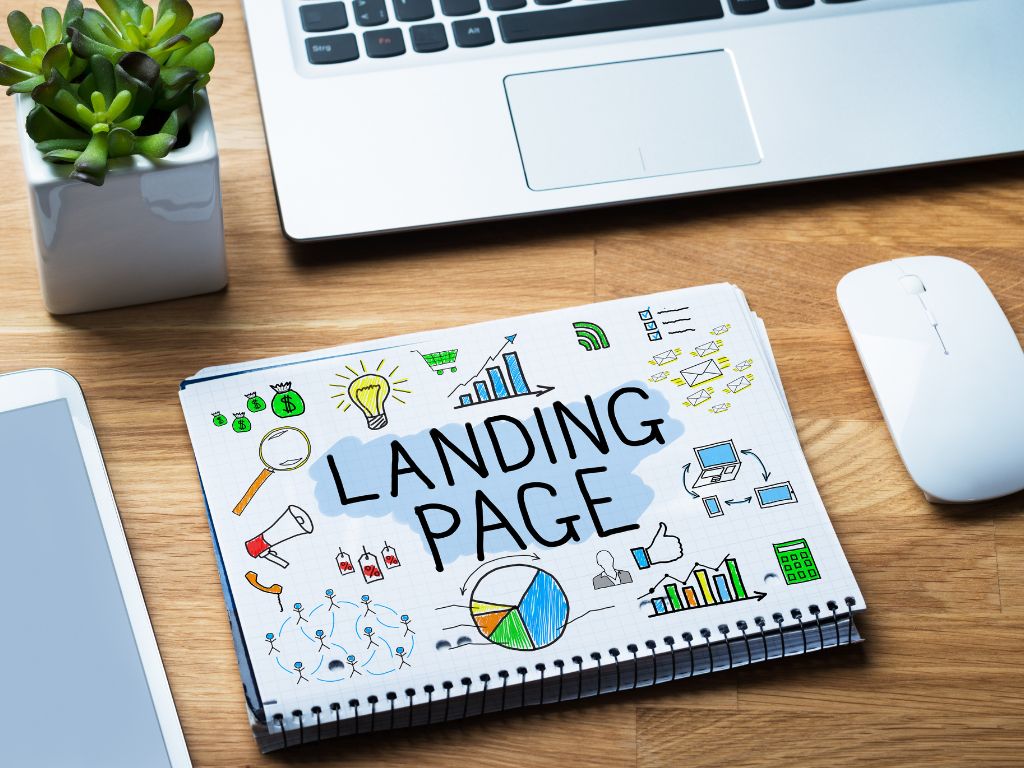
What Is a Lead Magnet Funnel? (And Why It Matters)
A lead magnet funnel is a simple system designed to do one thing: Turn strangers into email subscribers and subscribers into buyers.
It starts with a lead magnet, which is a free, high-value resource offered in exchange for an email address. This could be a checklist, a template, a swipe file, a quiz result, or a short guide. The only rule? It must solve a specific problem your audience cares about.
From there, the funnel does the work:
- The Landing Page: A focused page where people opt in to receive your lead magnet. No distractions. No fluff. Just a clear headline, strong benefit, and simple form.
- The Delivery Email: As soon as they opt in, they get the lead magnet in their inbox. This is your first impression. Make it personal, fast, and useful.
- The Follow-Up Sequence: A short series of emails that builds trust, shares value, and leads toward your core offer whether that’s a product, a service, or just more content.
Why does this matter?
Because attention spans are short. If you don’t capture interest fast, you lose the chance to build a relationship. A lead magnet funnel gives you a predictable way to grow your list, nurture your audience, and move them toward action, automatically.
The funnel isn’t the magic. The message is.
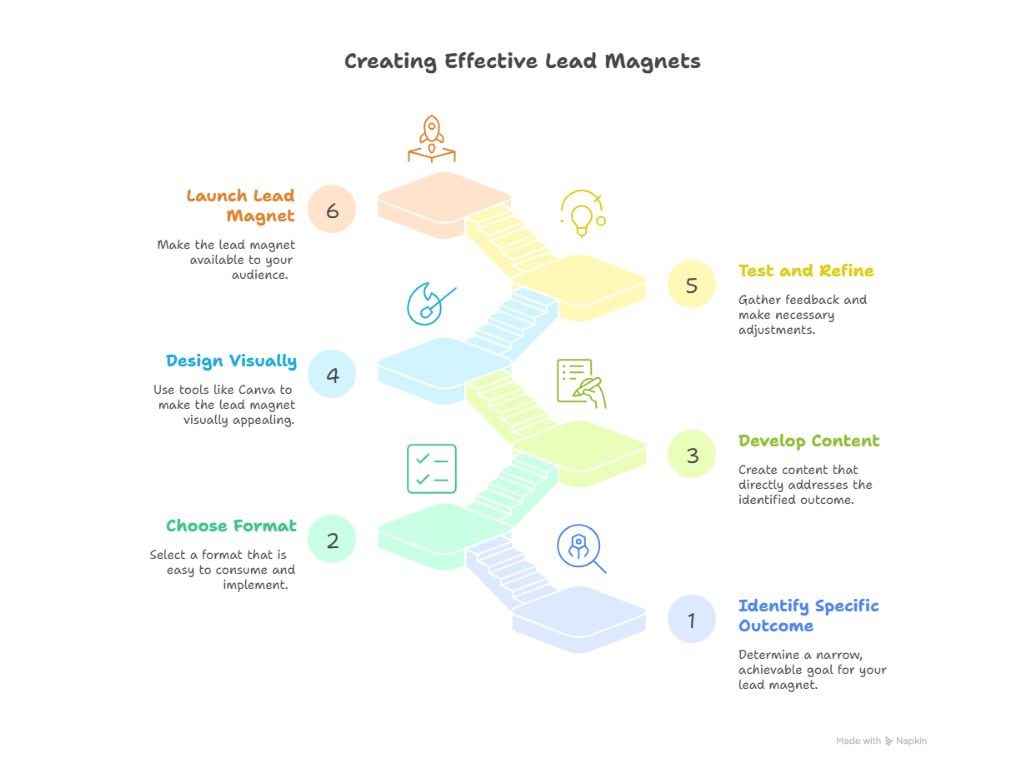
Create a Lead Magnet People Actually Want
Most lead magnets fail because they’re vague, bloated, or solving the wrong problem.
Nobody wants a “free guide” unless that guide unlocks something they care about. They don’t want a checklist. They want a shortcut. They don’t want an ebook. They want a result.
So how do you create a lead magnet that actually gets downloads?
Focus on one specific outcome.
The narrower the promise, the higher the conversion.
Example:
- Instead of “How to Build an Online Business”, offer “3 Plug-and-Play Email Templates to Get Your First Client”.
- Instead of “Ultimate Social Media Guide”, try “30-Day Instagram Story Planner for Coaches”.
Your goal isn’t to impress. It’s to solve something painful in five minutes or less.
Use formats people love to consume quickly:
- Checklists: Easy wins, fast implementation
- Swipe files: Pre-written scripts, headlines, email sequences
- Templates: Notion boards, Canva files, Google Docs
- Mini-audits: Self-assessments, scorecards
- Short tutorials: Quick wins in under 10 minutes
Don’t overthink it. You can create your first lead magnet in one day using ChatGPT, Canva, or Google Docs. Just pick a narrow problem and offer a simple solution.
People don’t need more content. They need clarity. They need shortcuts. They need you to make their life easier.
Build the Landing Page (That Doesn’t Kill Conversions)
This is where most funnels fall apart.
They’ve got a great lead magnet… but the landing page is a cluttered mess. Too many words. Too many distractions. No clear reason to care.
Your landing page has one job: get the visitor to say yes. Not later. Not maybe. Right now.
Here’s how to do it without overcomplicating anything:
1. Start with a headline that promises a result.
Skip the clever phrases. Clarity converts. Example:
- “Free Checklist: Launch Your First Freelance Offer in 30 Minutes”
- “Download 10 AI-Powered Content Prompts for Faster Social Posts”
2. Use 3–5 bullet points to highlight benefits.
Make each one outcome-focused. Think: “What’s in it for me?”
- Save hours of guesswork
- Use proven templates, not theory
- Get instant access no strings attached
3. Keep the opt-in form stupid simple.
Just ask for their email. First name optional. Anything more kills conversions.
Bonus tip: Make the call-to-action button specific. Instead of “Submit,” say “Get the Checklist” or “Send It to Me.”
4. Remove anything that doesn’t support the goal.
No menus. No blog links. No footer clutter. Every extra option is a potential exit.
You don’t need a fancy design. You need a sharp hook, a clear benefit, and a single action.
Tools like ConvertKit, Systeme.io, Carrd, or Leadpages make it easy. The magic isn’t in the platform, it’s in the message.
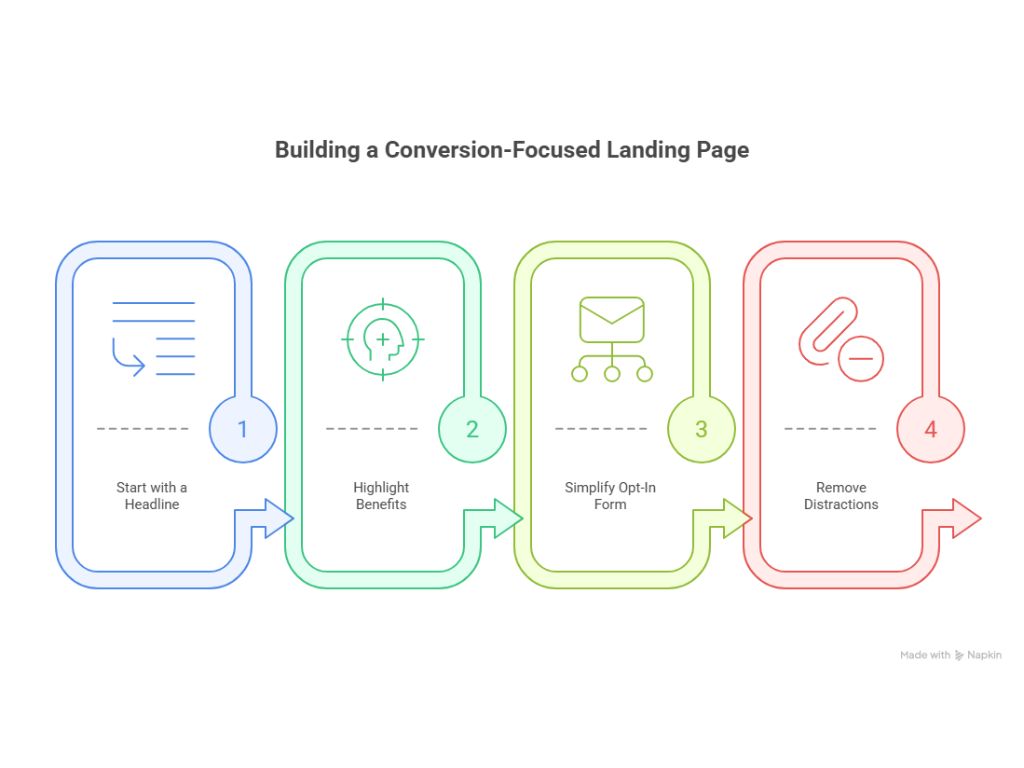
Automate the Follow-Up (Without Sounding Like a Bot)
The biggest mistake people make after someone signs up? They go silent.
No follow-up. No welcome. No connection. Just a cold inbox and a forgotten download.
Here’s the truth: your lead magnet gets attention but your emails build trust.
If you’re not following up, your funnel isn’t a funnel. It’s a dead end.
You don’t need a long, complicated sequence. Three strong emails can set the tone, build authority, and open the door for future action.
Let’s break it down:
Email 1: Deliver the Lead Magnet Instantly
This is your first impression. Don’t overthink it, just get to the point.
- Deliver the lead magnet as promised, right at the top
- Reinforce what the download will help them do
- Thank them for joining and set clear expectations
- End with a simple “watch your inbox” to build anticipation
Pro Tip: Most people only skim. Put the link or attachment front and center.
Email 2: Build Trust With a Quick Win
Send this one day later. You’re not selling anything yet, you’re helping.
Use this email to highlight one powerful insight from the lead magnet. Something they can use immediately. Something that reminds them, “this was worth it.”
You can also share a short personal story: a mistake you made, a lesson you learned, or a success that proves what you teach actually works.
Keep it conversational. End with a simple action or thought-provoking question. Your goal here is momentum, not conversion.
Email 3: Invite the Next Step
This is where most funnels fall flat, they either get pushy, or they disappear.
Instead, treat this like a conversation. Let them know where to go next. Maybe it’s a blog post. Maybe it’s a free training. Maybe it’s your paid offer if the timing feels right.
But whatever you share, make it feel like a natural extension of the value you already gave. Frame it as the next logical step in solving their problem, not a random pitch.
You’ve built attention and trust. Now invite them forward.
Automation doesn’t have to feel robotic. Use simple language. Write like a human. Speak directly to one person.
That’s how you turn a cold subscriber into a loyal fan or a future customer.
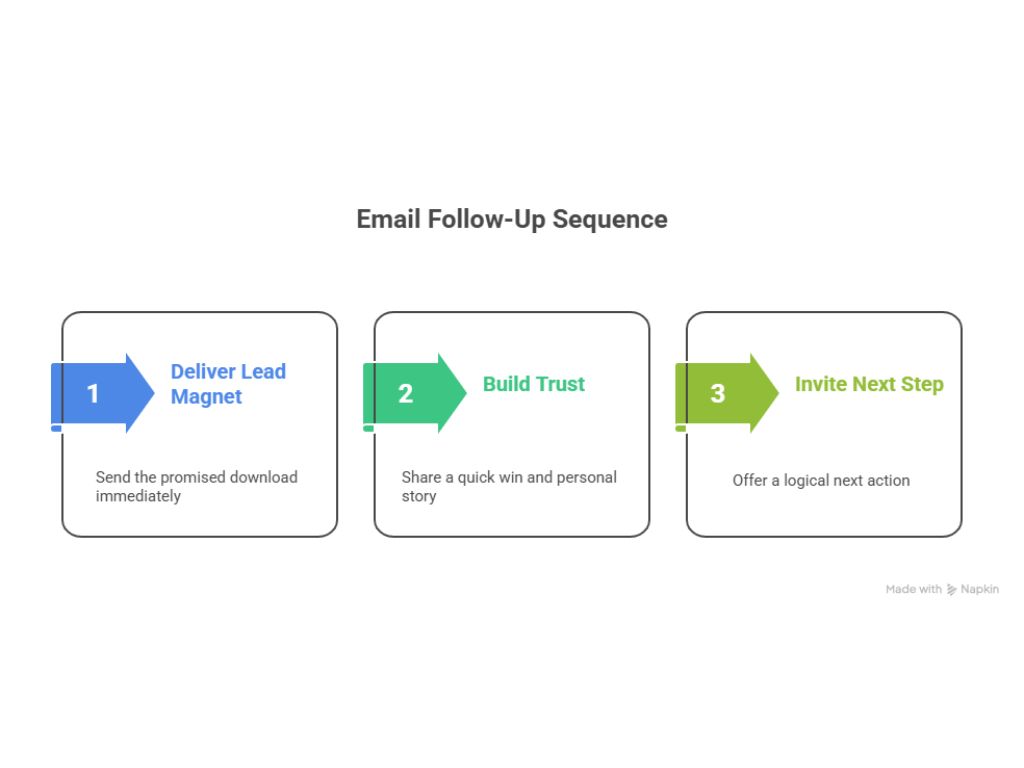
Optional Add-Ons to Boost Results
Once your lead magnet funnel is up and running, it’s tempting to just leave it alone.
And that’s fine for a while.
But if you want to turn steady trickles into real growth, a few simple enhancements can make a massive difference. These add-ons aren’t mandatory, but they’re powerful. You don’t need to rebuild your funnel, you just need to make it smarter.
Here’s how.
1. Exit-Intent Popups That Save the Opt-In
Most people won’t subscribe the first time they visit your landing page. That doesn’t mean they’re not interested, it just means they got distracted, uncertain, or busy.
An exit-intent popup gives you one final shot before they leave.
You can offer the same lead magnet again with a stronger headline. Or create a minimalist version like a checklist instead of a full guide. Keep it simple. Keep it sharp. The only goal is to recapture attention at the moment they try to leave.
This one tweak alone can recover 10 to 15 percent of lost traffic.
2. One-Question Quiz Funnels
Want higher engagement and better data? Ask one smart question before showing the lead magnet.
For example:
- “What’s your biggest challenge right now?”
- “Are you just getting started, or already earning?”
- “Which tool do you use most: Instagram, YouTube, or Email?”
Once they answer, you can send them a version of the lead magnet that matches their situation. The content may be the same, but the messaging feels personalized and that makes a big difference.
Even better, you now know more about your subscriber from day one, which helps you write better emails and promote smarter offers later.
3. Tripwire Offers That Convert Leads Into Customers
After someone opts in, they’re paying attention. That’s your best moment to offer something valuable even if it’s low cost.
A tripwire is a small, impulse-buy product that solves a related problem. Think $7 to $27.
- A checklist with bonus resources
- A swipe file with templates
- A Notion dashboard
- A short video training
You’re not trying to make money here. You’re shifting the relationship. Once someone buys from you even once, they’re far more likely to buy again later.
4. Thank You Page Upsells and CTAs
Most thank you pages are dead ends. They say “thanks” and nothing more. That’s a wasted opportunity.
Instead, guide your new subscriber somewhere meaningful.
- Invite them to binge your best content
- Offer a low-cost product
- Recommend your most helpful free resources
- Give them a bonus for referring a friend
- Send them to a webinar, a private community, or a waitlist
You’ve already earned their attention. Don’t stop the momentum. You don’t need to implement all of this at once.
Start simple. Launch fast. Then, over time, optimize each part of your funnel by adding what makes sense for your audience, your offer, and your goals.
The smartest funnels don’t look fancy. They feel intentional because every step leads somewhere valuable.
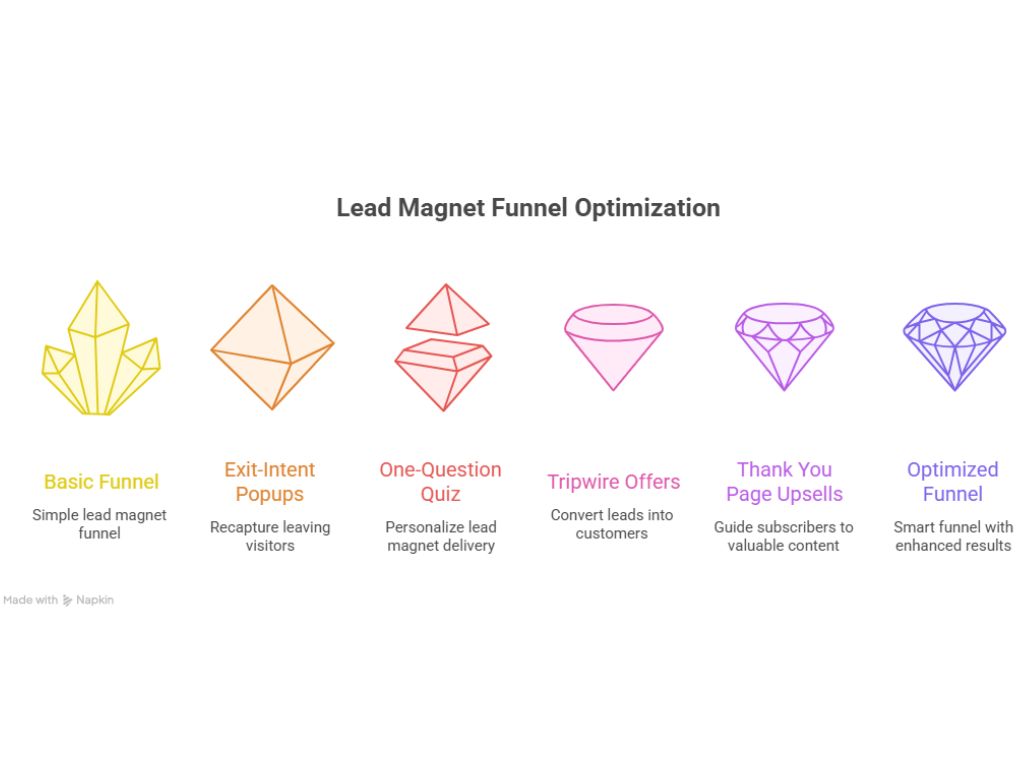
Lead Magnet Funnel: Common Funnel Mistakes to Avoid
Building a lead magnet funnel isn’t hard but messing it up is easy.
Most people blame the tool, the platform, or the tech. But the real reason funnels fail? Poor strategy, sloppy execution, or ignoring the basics.
Let’s break down the most common mistakes that kill conversions, waste time, and leave you wondering why nothing’s working.
Mistake 1: A Lead Magnet That’s Too Broad
“Free guide to online business.”
“10 tips for productivity.”
“Ultimate social media checklist.”
Vague promises don’t convert. Your audience isn’t looking for more information, they want specific results. If your lead magnet could apply to anyone, it will appeal to no one.
Fix it: Solve one focused problem. Deliver one clear win. Use clear language, not clever phrasing.
Mistake 2: Landing Pages With Too Much Noise
You’ve got a menu at the top. A footer full of links. A wall of text no one’s reading.
When someone lands on your opt-in page, they need three things:
What’s the offer, why does it matter, and where do I enter my email?
Fix it: Remove everything that doesn’t support that decision. No navigation. No distractions. Just a headline, bullets, a form, and a compelling CTA.
Mistake 3: Weak or Nonexistent Follow-Up
No email? No relationship. One email? Not enough. Ten boring emails? Nobody finishes them.
If all you do is deliver the lead magnet and disappear, you’re just another download buried in their inbox.
Fix it: Write three short emails. Be helpful. Be human. Lead them toward a logical next step. You’re not spamming, you’re showing up.
Mistake 4: Overthinking Every Detail and Never Launching
You tweak the colors. You rewrite the headline. You try three different tools. You reread everything five times and still haven’t published.
Funnels don’t need to be perfect. They need to exist.
Fix it: Get a basic version live. Test it. Improve based on data, not doubt.
The fastest-growing lists aren’t built on flashy tech. They’re built on clarity, simplicity, and fast action.
Avoid these traps and you’ll already be ahead of 90 percent of people trying to grow online.
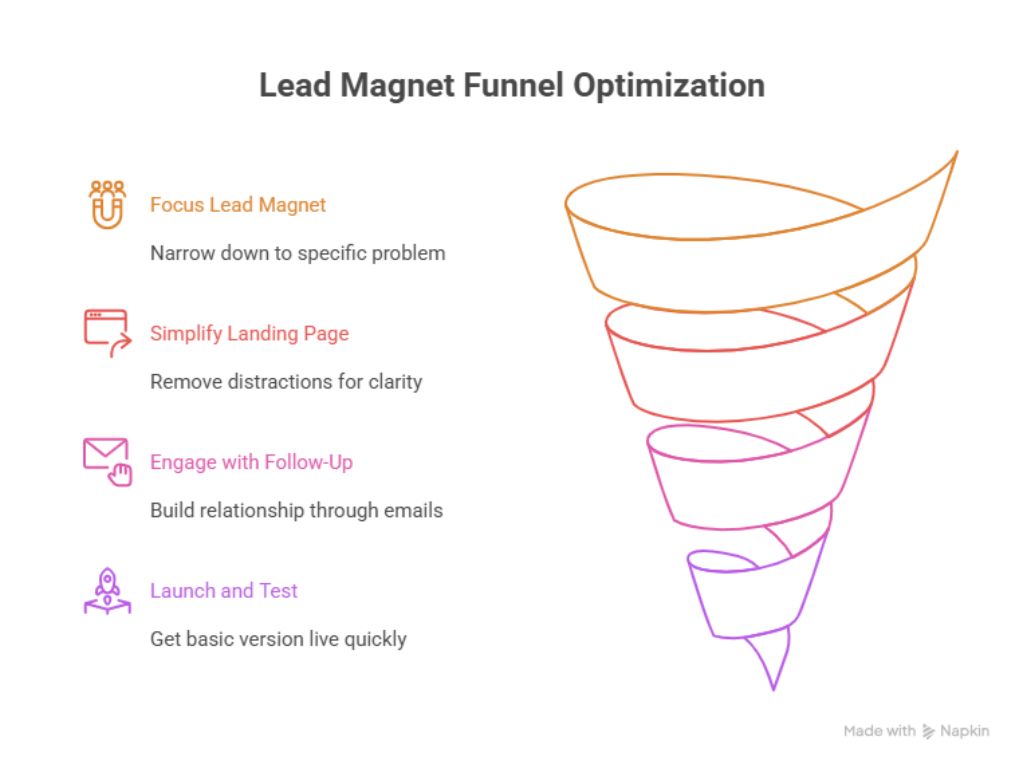
Final Word: Your Funnel Won’t Convert Until You Launch It
You’ve got the blueprint, you know what a lead magnet funnel is. and you understand how it works.
You’ve seen the pieces: a sharp offer, a clean landing page, a short email sequence, and a few smart upgrades that drive results.
Now comes the part most people skip: action.
Because here’s the uncomfortable truth: you can’t optimize a funnel that doesn’t exist.
You can’t grow a list you haven’t started. You can’t test a headline you haven’t written. You can’t learn from feedback if there’s nothing live to react to.
Want the fastest way to learn? Build a simple version. Put it in front of real people. Watch what happens. Then tweak, polish, and upgrade based on results not overthinking.
Forget perfection. Forget complexity. Your goal isn’t to launch the “perfect funnel.” Your goal is to launch one clear funnel that solves one real problem for one real person.
Start with that. The rest gets easier.
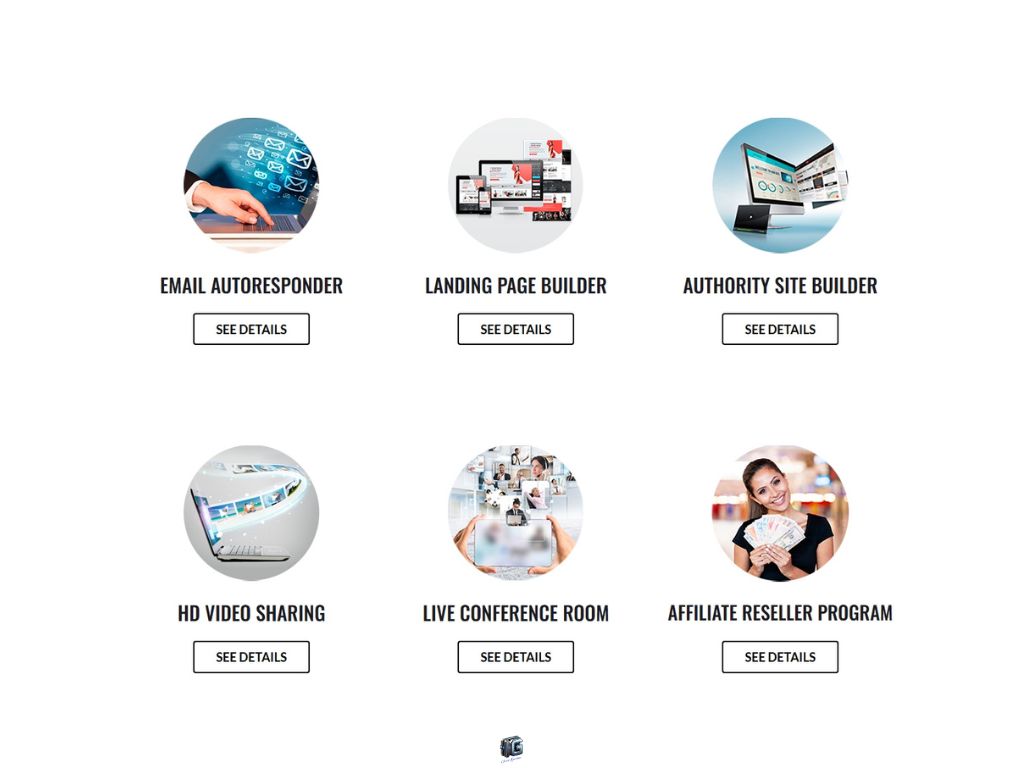
Frequently Asked Questions About Lead Magnet Funnels
1. What is a lead magnet funnel?
A lead magnet funnel is a simple marketing system designed to attract new subscribers by offering something valuable in exchange for their email. It typically includes a landing page, a lead magnet (like a checklist or template), and an automated email sequence that nurtures the subscriber toward a product, service, or deeper relationship.
2. What makes a good lead magnet?
A good lead magnet solves one specific problem quickly. It should be easy to consume, highly relevant to your audience, and directly tied to the next step in your funnel. The best formats include checklists, swipe files, templates, short guides, or quiz results anything that delivers a clear win in under 10 minutes.
3. Do I need expensive tools to set up a funnel?
Not at all. Many creators build effective lead magnet funnels using free or low-cost tools like Systeme.io, ConvertKit, Carrd, or MailerLite. Focus on your message and offer first tools only enhance a strategy that’s already working.
4. How many emails should be in my follow-up sequence?
Start with three. That’s enough to welcome your subscriber, deliver the lead magnet, share a quick win, and invite them to take the next step. You can always expand later based on feedback and engagement.
5. Can a lead magnet funnel work without a big audience?
Yes. A funnel works even if you’re starting from zero. In fact, it’s one of the best ways to grow your audience. You can promote it through social media, blog content, collaborations, or even a small paid ad budget. The key is targeting a specific problem for a specific person not trying to attract everyone.
0 Comments